
Landmarks of Saint Petersburg
Encyclopedia

St. Petersburg's position below the Arctic Circle
Arctic Circle
The Arctic Circle is one of the five major circles of latitude that mark maps of the Earth. For Epoch 2011, it is the parallel of latitude that runs north of the Equator....
, on the same latitude
Latitude
In geography, the latitude of a location on the Earth is the angular distance of that location south or north of the Equator. The latitude is an angle, and is usually measured in degrees . The equator has a latitude of 0°, the North pole has a latitude of 90° north , and the South pole has a...
as nearby Helsinki
Helsinki
Helsinki is the capital and largest city in Finland. It is in the region of Uusimaa, located in southern Finland, on the shore of the Gulf of Finland, an arm of the Baltic Sea. The population of the city of Helsinki is , making it by far the most populous municipality in Finland. Helsinki is...
, Stockholm
Stockholm
Stockholm is the capital and the largest city of Sweden and constitutes the most populated urban area in Scandinavia. Stockholm is the most populous city in Sweden, with a population of 851,155 in the municipality , 1.37 million in the urban area , and around 2.1 million in the metropolitan area...
, Aberdeen
Aberdeen
Aberdeen is Scotland's third most populous city, one of Scotland's 32 local government council areas and the United Kingdom's 25th most populous city, with an official population estimate of ....
and Oslo
Oslo
Oslo is a municipality, as well as the capital and most populous city in Norway. As a municipality , it was established on 1 January 1838. Founded around 1048 by King Harald III of Norway, the city was largely destroyed by fire in 1624. The city was moved under the reign of Denmark–Norway's King...
(60° N
Latitude
In geography, the latitude of a location on the Earth is the angular distance of that location south or north of the Equator. The latitude is an angle, and is usually measured in degrees . The equator has a latitude of 0°, the North pole has a latitude of 90° north , and the South pole has a...
), causes twilight to last all night in May, June and July. This phenomenon is known as the "white nights". The white nights are closely linked to another attraction — the eight drawbridge
Drawbridge
A drawbridge is a type of movable bridge typically associated with the entrance of a castle surrounded by a moat. The term is often used to describe all different types of movable bridges, like bascule bridges and lift bridges.-Castle drawbridges:...
s spanning the Neva. The bridges are drawn from May to late October according to a special schedule, between approximately 2 a.m. and 4:30 a.m. to allow shipping to pass up and down the river. Every night during the navigation period from April to November, 22 bridges across Neva and main canals are drawn to let ships pass in and out of the Baltic Sea.
The historical center of St. Petersburg
Historic Centre of Saint Petersburg and Related Groups of Monuments
Historic Centre of Saint Petersburg and Related Groups of Monuments is the name used by UNESCO when it collectively designated the historic core of the Russian city of St...
was the first Russian patrimony inscribed on the UNESCO
UNESCO
The United Nations Educational, Scientific and Cultural Organization is a specialized agency of the United Nations...
list of World Heritage Sites.
Canals and bridges
[:Trinity Bridge.jpg|thumb|right|The Trinity Bridge]]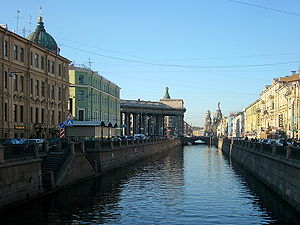

The Great designed the city as another Amsterdam
Amsterdam
Amsterdam is the largest city and the capital of the Netherlands. The current position of Amsterdam as capital city of the Kingdom of the Netherlands is governed by the constitution of August 24, 1815 and its successors. Amsterdam has a population of 783,364 within city limits, an urban population...
and Venice
Venice
Venice is a city in northern Italy which is renowned for the beauty of its setting, its architecture and its artworks. It is the capital of the Veneto region...
, with canals instead of streets and citizens skilful in sailing. Initially, there were only about ten bridges constructed in the city, mainly across ditches and minor creeks. According to Peter's plans, in the summer months, the citizens were supposed to move around in boats, and in the winter months when the water froze to move in sledges. However, after Peter's death, new bridges were built as it was a much easier way of transportation. Temporary pontoon bridge
Pontoon bridge
A pontoon bridge or floating bridge is a bridge that floats on water and in which barge- or boat-like pontoons support the bridge deck and its dynamic loads. While pontoon bridges are usually temporary structures, some are used for long periods of time...
s were built across Neva in the summertime. The largest temporary bridge across the Bolshaya Neva
Bolshaya Neva
Bolshaya Neva is the largest armlet of Neva river. It starts near the Vasilievsky Island's Strelka .The length of Bolshaya Neva is 3.5 km, the width is from 200 to 400 meters, depth up to 12.8 meters...
was in operation from 1727 to 1850.
The first permanent bridge of bricks and stones across the main waters of Bolshaya Neva river was the Lieutenant Schmidt Bridge
Lieutenant Schmidt Bridge
The Blagoveshchensky Bridge is the first permanent bridge built across the Neva River in Saint Petersburg, Russia. It connects Vasilievsky Island and the central part of the city . The bridge's length is 331 meters and the width was 24 meters. The original name of the bridge was Nevsky Bridge. It...
, built from 1843 to 1850, and opened in 1850.
Today, there are 341 bridges over canals and rivers of various sizes, styles and constructions, built at different periods. Over 800 smaller bridges over smaller ponds and streams are gracing public parks and gardens.
Thanks to the intricate web of canals, St. Petersburg is often called the "Venice of the North" which is a popular poetic name for the northern capital.
Palaces of the Tsars

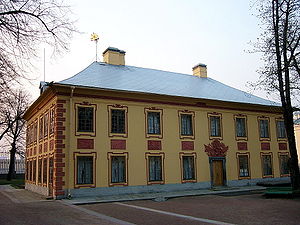
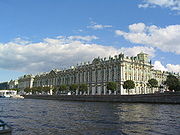
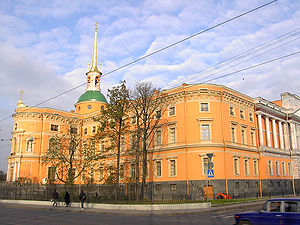
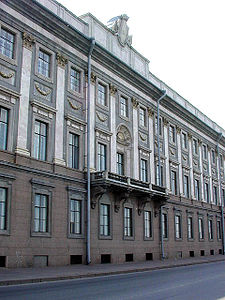
Palace
A palace is a grand residence, especially a royal residence or the home of a head of state or some other high-ranking dignitary, such as a bishop or archbishop. The word itself is derived from the Latin name Palātium, for Palatine Hill, one of the seven hills in Rome. In many parts of Europe, the...
s. One of the earliest of these is the Summer Palace
Summer Palace of Peter the Great
The Summer Palace is a diminutive residence of Peter the Great that was built in 1710-14 in his new capital, St. Petersburg, on the bank of the Fontanka River, in what is now the Summer Garden. The design was by Domenico Trezzini...
, a modest house built for Peter I
Peter I of Russia
Peter the Great, Peter I or Pyotr Alexeyevich Romanov Dates indicated by the letters "O.S." are Old Style. All other dates in this article are New Style. ruled the Tsardom of Russia and later the Russian Empire from until his death, jointly ruling before 1696 with his half-brother, Ivan V...
in the Summer Garden
Summer Garden
The Summer Garden occupies an island between the Fontanka, Moika, and the Swan Canal in Saint Petersburg and shares its name with the adjacent Summer Palace of Peter the Great.-Original:...
(1710–1714). Much more imposing are the baroque
Baroque
The Baroque is a period and the style that used exaggerated motion and clear, easily interpreted detail to produce drama, tension, exuberance, and grandeur in sculpture, painting, literature, dance, and music...
residences
House
A house is a building or structure that has the ability to be occupied for dwelling by human beings or other creatures. The term house includes many kinds of different dwellings ranging from rudimentary huts of nomadic tribes to free standing individual structures...
of his associates, such as the Kikin Hall and the Menshikov Palace
Menshikov Palace
The Menshikov Palace is a Petrine Baroque edifice in Saint Petersburg, situated on Universitetskaya Embankment of the Bolshaya Neva on Vasilyevsky Island. It was the first stone building in the city...
on the Neva Embankment, constructed from designs by Domenico Trezzini
Domenico Trezzini
Domenico Trezzini was a Swiss Italian architect who elaborated the Petrine Baroque style of Russian architecture.Domenico was born in Astano, near Lugano, in the Italian-speaking Ticino . He probably studied in Rome...
over the years 1710 to 1716. A residence adjacent to the Menshikov palace was redesigned for Peter II
Peter II of Russia
Pyotr II Alekseyevich was Emperor of Russia from 1727 until his death. He was the only son of Tsarevich Alexei Petrovich, son of Peter I of Russia by his first wife Eudoxia Lopukhina, and Princess Charlotte, daughter of Duke Louis Rudolph of Brunswick-Lüneburg and sister-in-law of Charles VI,...
and now houses the State University
Saint Petersburg State University
Saint Petersburg State University is a Russian federal state-owned higher education institution based in Saint Petersburg and one of the oldest and largest universities in Russia....
.
The baroque Winter Palace
Winter Palace
The Winter Palace in Saint Petersburg, Russia, was, from 1732 to 1917, the official residence of the Russian monarchs. Situated between the Palace Embankment and the Palace Square, adjacent to the site of Peter the Great's original Winter Palace, the present and fourth Winter Palace was built and...
(1754–1762) is a vast stately building with over 600 rooms and dazzlingly luxurious interiors, now housing the Hermitage Museum
Hermitage Museum
The State Hermitage is a museum of art and culture in Saint Petersburg, Russia. One of the largest and oldest museums of the world, it was founded in 1764 by Catherine the Great and has been opened to the public since 1852. Its collections, of which only a small part is on permanent display,...
. The same architect, Bartolomeo Rastrelli
Bartolomeo Rastrelli
Francesco Bartolomeo Rastrelli was an Italian architect naturalized Russian. He developed an easily recognizable style of Late Baroque, both sumptuous and majestic...
, was also responsible for three residences in the vicinity of the Nevsky Prospekt
Nevsky Prospekt
Nevsky Avenue |Prospekt]]) is the main street in the city of St. Petersburg, Russia. Planned by Peter the Great as beginning of the road to Novgorod and Moscow, the avenue runs from the Admiralty to the Moscow Railway Station and, after making a turn at Vosstaniya Square, to the Alexander...
: the Stroganov Palace
Stroganov Palace
The Stroganov Palace is a Late Baroque palace at the intersection of the Moika River and Nevsky Prospekt in Saint Petersburg, Russia. The palace was built to Bartolomeo Rastrelli's designs for Baron Sergei Grigoriyevich Stroganov in 1753-1754...
(1752–1754, is now a branch of the State Russian Museum, the Vorontsov
Mikhail Illarionovich Vorontsov
Count Mikhail Illarionovich Vorontsov was a Russian statesman and diplomat, who laid foundations for the fortunes of the Vorontsov family....
palace (1749–1757, now a military school), and the Anichkov Palace
Anichkov Palace
Anichkov Palace is a former imperial palace in Saint Petersburg, at the intersection of Nevsky Avenue and the Fontanka.-History:The palace, situated on the plot formerly owned by Antonio de Vieira, takes its name from the nearby Anichkov Bridge across the Fontanka...
(1741–1750, many times rebuilt, now a palace for extracurricular schooling). Other baroque palaces include the Sheremetev
Sheremetev
The Sheremetev family was one of the wealthiest and most influential noble families of Russia.The family held many high commanding ranks in the Russian military, governorships and eventually the rank of Count of the Russian Empire...
house on the Fontanka
Fontanka
Fontanka is a left branch of the river Neva, which flows through the whole of Central Saint Petersburg, Russia. Its length is 6,700 meters, its width is up to 70 meters, and its depth is up to 3,5 meters. The Fontanka Embankment is lined with the former private residences of Russian nobility.This...
embankment (also called the Fountain House), and the Beloselsky-Belozersky Palace
Beloselsky-Belozersky Palace
Belosselsky-Belozersky Palace is a Neo-Baroque palace at the intersection of the Fontanka River and Nevsky Prospekt in Saint Petersburg, Russia...
(1846–1848) on the Nevsky Prospekt, formerly a residence of the Grand Duke Sergey Aleksandrovich
Grand Duke Sergei Alexandrovich of Russia
Grand Duke Sergei Alexandrovich of Russia was a son of Emperor Alexander II of Russia...
.
St Michael's (or Engineers') Castle, a Neoclassical
Neoclassicism
Neoclassicism is the name given to Western movements in the decorative and visual arts, literature, theatre, music, and architecture that draw inspiration from the "classical" art and culture of Ancient Greece or Ancient Rome...
palace, was constructed for Emperor Paul
Paul I of Russia
Paul I was the Emperor of Russia between 1796 and 1801. He also was the 72nd Prince and Grand Master of the Order of Malta .-Childhood:...
in 1797–1801 to replace the earlier Summer Palace. The Tauride Palace
Tauride Palace
Tauride Palace is one of the largest and most historic palaces in Saint Petersburg, Russia.- Potemkin :...
of Prince Potemkin (1783–1789), situated near the Smolny Institute, used to be a seat of the first Russian parliament
Duma
A Duma is any of various representative assemblies in modern Russia and Russian history. The State Duma in the Russian Empire and Russian Federation corresponds to the lower house of the parliament. Simply it is a form of Russian governmental institution, that was formed during the reign of the...
, and now the Assembly of Independent States. Just two blocks from the Hermitage buildings is the Marble Palace
Marble Palace
Marble Palace is one of the first Neoclassical palaces in Saint Petersburg, Russia. It is situated between the Field of Mars and Palace Quay, slightly to the east from New Michael Palace....
, commissioned by Count Orlov and built in 1768–1785 from 44 various sorts of marble
Marble
Marble is a metamorphic rock composed of recrystallized carbonate minerals, most commonly calcite or dolomite.Geologists use the term "marble" to refer to metamorphosed limestone; however stonemasons use the term more broadly to encompass unmetamorphosed limestone.Marble is commonly used for...
to a Neoclassical design by Antonio Rinaldi, it is now part of the State Russian Museum. The Michael Palace (1819–1825), famed for its opulent interiors and named after its first lodger, Grand Duke Mikhail Pavlovich, now houses the main collections of the Russian Museum
Russian Museum
The State Russian Museum is the largest depository of Russian fine art in St Petersburg....
. Also designed in the Neoclassical style is the Yusupov
Yusupov
Yusupov or Yusupova is a Russian surname of Tatar origin. It may refer to:*House of Yusupov, noble Russian family**Felix Yusupov , Count Sumarokov-Elston, Russian aristocrat and one of the participants in the murder of Grigori Rasputin**Irina Yusupova , Russian Princess and daughter of Count...
's Moyka palace (built in the 1790s), where Rasputin was killed by Prince Yusupov. Other palaces are the Razumovsky
Kirill Razumovsky
Count Kirill Grigorievich Razumovsky was a Ukrainian Registered Cossack from the Kozelets regiment in north-eastern Ukraine, who served as the last Hetman of Left- and Right-Bank Ukraine until 1764; Razumovsky was subsequently elected Hetman of the sovereign Zaporozhian Host in 1759, a position...
palace (1762–1766); the Shuvalov
Peter Ivanovich Shuvalov
Count Pyotr Ivanovich Shuvalov was a Russian statesman and Field Marshal who, together with his brother Aleksandr Shuvalov, paved the way for the elevation of the Shuvalov family to the highest offices of the Russian Empire...
palace (1830–1838); and the Yelagin Palace
Yelagin Palace
Yelagin Palace completed in 1822 is a palace in Saint Petersburg which is situated on Yelagin Island in the Neva River and served as a royal summer palace during the reign of Tsar Alexander I...
(1818–1822), a sumptuous summer dacha
Dacha
Dacha is a Russian word for seasonal or year-round second homes often located in the exurbs of Soviet and post-Soviet cities. Cottages or shacks serving as family's main or only home are not considered dachas, although many purpose-built dachas are recently being converted for year-round residence...
of the imperial family, situated on the Yelagin Island
Yelagin Island
Yelagin Island is an island at the mouth of the Neva River which is part of St. Petersburg, Russia. Yelagin Island is home to the Yelagin Palace but has few other buildings; the island initially served as a wooded retreat for the ruling class...
. The last Royal residences were built for Nicholas I
Nicholas I of Russia
Nicholas I , was the Emperor of Russia from 1825 until 1855, known as one of the most reactionary of the Russian monarchs. On the eve of his death, the Russian Empire reached its historical zenith spanning over 20 million square kilometers...
's children: the Mariinsky Palace
Mariinsky Palace
Mariinsky Palace, also known as Marie Palace , was the last Neoclassical imperial palace to be constructed in Saint Petersburg, Russia. It was built between 1839 and 1844 to a design by the court architect Andrei Stackensneider....
(1839–1844), located just opposite St Isaac's Cathedral, is now housing the St. Petersburg City Legislature
Legislature
A legislature is a kind of deliberative assembly with the power to pass, amend, and repeal laws. The law created by a legislature is called legislation or statutory law. In addition to enacting laws, legislatures usually have exclusive authority to raise or lower taxes and adopt the budget and...
and Offices of Representatives, the Nicholas Palace
Nicholas Palace
Nicholas Palace was one of several St Petersburg palaces designed by Andreas Stackensneider for the children of Nicholas I of Russia...
(1853–61), and the New Mikhaylovsky Palace (1857-1861). All major palaces are now housing numerous state and private museums and various branches of the government.
Cathedrals and temples
While many cathedrals and buildings formerly owned by churches and monasteries still belong to the Russian government, since their seizure in 1917, some were eventually returned to congregations. The largest cathedralCathedral
A cathedral is a Christian church that contains the seat of a bishop...
in the city is St Isaac's Cathedral, said to have the largest gold-plated dome
Dome
A dome is a structural element of architecture that resembles the hollow upper half of a sphere. Dome structures made of various materials have a long architectural lineage extending into prehistory....
in the world. It was constructed 1818–1858 under the supervision of architects Auguste de Montferrand
Auguste de Montferrand
Auguste de Montferrand was a French Neoclassical architect who worked primarily in Russia. His two best known works are the Saint Isaac's Cathedral and the Alexander Column in St. Petersburg.-Family:...
and Vasily Stasov
Vasily Stasov
Vasily Petrovich Stasov was a Russian architect.-Biography:Stasov was born in Moscow....
.
The Kazan Cathedral on the Nevsky Prospekt was modeled after St Peter's, Vatican
St. Peter's Basilica
The Papal Basilica of Saint Peter , officially known in Italian as ' and commonly known as Saint Peter's Basilica, is a Late Renaissance church located within the Vatican City. Saint Peter's Basilica has the largest interior of any Christian church in the world...
in the Empire style.
The Church of the Savior on Blood
Church of the Savior on Blood
The Church of the Savior on Spilled Blood Khram Spasa na Krovi is one of the main sights of St. Petersburg, Russia. It is also variously called the Church on Spilt Blood and the Cathedral of the Resurrection of Christ , its official name....
(1883–1907), is a monument in the old Russian style
Russian architecture
Russian architecture follows a tradition whose roots were established in the Eastern Slavic state of Kievan Rus'. After the fall of Kiev, Russian architectural history continued in the principalities of Vladimir-Suzdal, Novgorod, the succeeding states of the Tsardom of Russia, the Russian Empire,...
which marks the spot of Alexander II
Alexander II of Russia
Alexander II , also known as Alexander the Liberator was the Emperor of the Russian Empire from 3 March 1855 until his assassination in 1881...
's assassination.
The Peter and Paul Cathedral
Peter and Paul Cathedral
The Peter and Paul Cathedral is a Russian Orthodox cathedral located inside the Peter and Paul Fortress in St. Petersburg, Russia. It is the first and oldest landmark in St. Petersburg, built between 1712 and 1733 on Zayachy Island along the Neva River. Both the cathedral and the fortress were...
(1712–1732), a long-time symbol
Symbol
A symbol is something which represents an idea, a physical entity or a process but is distinct from it. The purpose of a symbol is to communicate meaning. For example, a red octagon may be a symbol for "STOP". On a map, a picture of a tent might represent a campsite. Numerals are symbols for...
of the city, contains the sepulchers
Sepulchre
The rock-cut tombs in ancient Israel are a group of hundreds of rock-cut tombs constructed in Israel in ancient times. They were cut into the rock, sometimes with elaborate facades and multiple burial chambers. Some are free-standing, but most are caves. Each tomb typically belonged to a...
of Peter the Great
Peter I of Russia
Peter the Great, Peter I or Pyotr Alexeyevich Romanov Dates indicated by the letters "O.S." are Old Style. All other dates in this article are New Style. ruled the Tsardom of Russia and later the Russian Empire from until his death, jointly ruling before 1696 with his half-brother, Ivan V...
and other Russian emperors
Tsar
Tsar is a title used to designate certain European Slavic monarchs or supreme rulers. As a system of government in the Tsardom of Russia and Russian Empire, it is known as Tsarist autocracy, or Tsarism...
. The St. Nicholas Cathedral and the Great Choral Synagogue are near the Mariinsky Opera Theatre. Most cathedrals and temples operate today as places of worship as well as museum
Museum
A museum is an institution that cares for a collection of artifacts and other objects of scientific, artistic, cultural, or historical importance and makes them available for public viewing through exhibits that may be permanent or temporary. Most large museums are located in major cities...
s, and there are numerous other places of worship in all major religions.
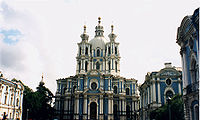
Smolny Convent
Smolny Convent or Smolny Convent of the Resurrection , located on Ploschad Rastrelli, on the bank of the River Neva in Saint Petersburg, Russia, consists of a cathedral and a complex of buildings surrounding it, originally intended for a convent.-History:This Russian Orthodox convent was built to...
(1748–1764), later the Smolny Institute, designed by Bartolomeo Rastrelli
Bartolomeo Rastrelli
Francesco Bartolomeo Rastrelli was an Italian architect naturalized Russian. He developed an easily recognizable style of Late Baroque, both sumptuous and majestic...
, but never completed. It is followed by the Naval Cathedral of St Nicholas (1753–1762), a lofty structure dedicated to the Russian Navy, the outside being covered with plaques
Commemorative plaque
A commemorative plaque, or simply plaque, is a plate of metal, ceramic, stone, wood, or other material, typically attached to a wall, stone, or other vertical surface, and bearing text in memory of an important figure or event...
to sailors lost at sea. The church of Sts. Simeon and Anna (1731–1734), St. Sampson Cathedral (1728–1740), St. Pantaleon Church (1735–1739), and St. Andrew's Cathedral
St. Andrew's Cathedral, St. Petersburg
Saint Andrew's Cathedral was the last Baroque cathedral built in Saint Petersburg, Russia.The cathedral was conceived at the time of Peter the Great as the chapter church of Russia's first chivalric order, that of Saint Andrew...
(1764–1780) are also notable.
The Neoclassical churches are numerous. Many of them are intended to dominate squares
Town square
A town square is an open public space commonly found in the heart of a traditional town used for community gatherings. Other names for town square are civic center, city square, urban square, market square, public square, and town green.Most town squares are hardscapes suitable for open markets,...
, like St. Vladimir's Cathedral (1769–1789), not to be confused with the church of Our Lady of Vladimir (1761–1783). The Transfiguration Cathedral
Transfiguration Cathedral (Saint Petersburg)
Transfiguration Cathedral is an Eastern Orthodox cathedral belonging to the Diocese of St. Petersburg. It is located on Transfiguration Square , just off Liteyny Prospekt near the Chernyshevskaya metro station...
(1827–29) and the Trinity Cathedral
Trinity Cathedral, St. Petersburg
The Trinity Cathedral , sometimes called the Troitsky Cathedral, in Saint Petersburg, Russia, is a late example of the Empire style, built between 1828 and 1835 to a design by Vasily Stasov...
(1828–1835, fire-damaged) were both designed by Vasily Stasov
Vasily Stasov
Vasily Petrovich Stasov was a Russian architect.-Biography:Stasov was born in Moscow....
. Smaller churches include the Konyushennaya (1816–1823), also by Stasov, the "Easter Cake" church (1785–1787), noted for its droll appearance, St Catherine church on the Vasilievsky Island
Vasilievsky Island
Vasilyevsky Island is an island in Saint Petersburg, Russia, bordered by the rivers Bolshaya Neva and Malaya Neva in the south and northeast, and by the Gulf of Finland in the west. Vasilyevsky Island is separated from Dekabristov Island by the Smolenka River...
(1768–1771), and numerous non-Orthodox churches on the Nevsky Prospekt.
The Alexander Nevsky Monastery, intended to house the relics of St. Alexander Nevsky
Alexander Nevsky
Alexander Nevsky was the Prince of Novgorod and Grand Prince of Vladimir during some of the most trying times in the city's history. Commonly regarded as the key figure of medieval Rus, Alexander was the grandson of Vsevolod the Big Nest and rose to legendary status on account of his military...
, is graced by two cathedrals and five smaller churches in various styles. The monastery is also one of three main centers of Christian
Christian
A Christian is a person who adheres to Christianity, an Abrahamic, monotheistic religion based on the life and teachings of Jesus of Nazareth as recorded in the Canonical gospels and the letters of the New Testament...
education in Russia, having the Russian Orthodox Academy and Seminary and the residence of the St. Petersburg Patriarch. It is also remarkable for the Tikhvin Cemetery
Tikhvin Cemetery
Tikhvin Cemetery is located at the Alexander Nevsky Monastery, in Saint Petersburg, Russia.Established in 1823, some of the notables buried here are:* Mily Balakirev - , composer* Alexander Borodin - , composer...
, with graves of such dignitaries as writers Fyodor Dostoyevsky and Ivan Krylov
Ivan Krylov
Ivan Andreyevich Krylov is Russia's best known fabulist. While many of his earlier fables were loosely based on Aesop and Jean de La Fontaine, later fables were original work, often satirizing the incompetent bureaucracy that was stifling social progress in his time.-Life:Ivan Krylov was born in...
, composers Pyotr Ilyich Tchaykovsky and Modest Mussorgsky
Modest Mussorgsky
Modest Petrovich Mussorgsky was a Russian composer, one of the group known as 'The Five'. He was an innovator of Russian music in the romantic period...
, pianist Anton Rubinstein
Anton Rubinstein
Anton Grigorevich Rubinstein was a Russian-Jewish pianist, composer and conductor. As a pianist he was regarded as a rival of Franz Liszt, and he ranks amongst the great keyboard virtuosos...
, director Georgy Tovstonogov
Georgy Tovstonogov
Georgy Alexandrovich Tovstonogov was a Russian theatre director, the leader of Saint Petersburg Bolshoi Academic Theatre of Drama , which now bears his name.-Biography:...
, actors Fyodor Stravinsky
Fyodor Stravinsky
Fyodor Ignatievich Stravinsky ) was a Russian bass opera singer and actor. He was the father of Igor Stravinsky and the grandfather of Soulima Stravinsky....
, Vera Komissarzhevskaya
Vera Komissarzhevskaya
Vera Fyodorovna Komissarzhevskaya was the most celebrated Russian actress at the turn of the twentieth century.Vera Komissarzhevskaya was the daughter of Fyodor Komissarzhevsky, a leading tenor of the Mariinsky Theatre, and sister of Theodore Komisarjevsky, a famous theatrical director...
, Nikolay Simonov, mayor Anatoly Sobchak
Anatoly Sobchak
Anatoly Alexandrovich Sobchak was a Russian politician, a co-author of the Constitution of the Russian Federation, the first democratically elected mayor of Saint Petersburg, and a mentor and teacher of both Vladimir Putin and Dmitry Medvedev....
and many other notable Russians.
The Grand Choral Synagogue of St. Petersburg is the second largest in Europe. It was opened in 1893, with the building permit obtained in 1869 from the Tsar Alexander II
Alexander II of Russia
Alexander II , also known as Alexander the Liberator was the Emperor of the Russian Empire from 3 March 1855 until his assassination in 1881...
. The Small Synagogue was opened in 1886. On 5 Tamuz 5761 (June 26, 2001), the greater hall ("Bolshoi Zal" in Russian) was reopened after reconstruction.
Two small churches in the early Gothic Revival style, both designed by Yuri Felten, are the St John the Baptist (1776–1781) and the Chesmenskaya
Chesme Church
The Chesme Church , also called the Church of the Nativity of St. John the Baptist, is a small Russian Orthodox church at 12 Lensoveta Street, in Saint Petersburg, Russia. It was built by the Russian court architect Yury Felten in 1780 at the direction of Catherine the Great, Empress of Russia...
(1777–1780). The late 19th century and early 20th century temples are designed in the Russian Revival
Russian Revival
The Russian Revival style is the generic term for a number of different movements within Russian architecture that arose in second quarter of the 19th century and was an eclectic melding of pre-Peterine Russian architecture and elements of Byzantine architecture.The Russian Revival style arose...
or Byzantine Revival
Byzantine architecture
Byzantine architecture is the architecture of the Byzantine Empire. The empire gradually emerged as a distinct artistic and cultural entity from what is today referred to as the Roman Empire after AD 330, when the Roman Emperor Constantine moved the capital of the Roman Empire east from Rome to...
styles. Saint Petersburg Mosque
Saint Petersburg Mosque
The Saint Petersburg Mosque , when opened in 1913, was the largest mosque in Europe, its minarets attaining 49 meters in height and the impressive dome rising 39 meters high. The mosque is situated in downtown St Petersburg, so its azure dome is perfectly visible from the Trinity Bridge across the...
(1909–1920), once the largest in Europe, is modeled after the Gur-e Amir
Gur-e Amir
The Gūr-e Amīr or Guri Amir is a mausoleum of the Asian conqueror Tamerlane in Samarkand, Uzbekistan. It occupies an important place in the history of Persian Architecture as the precursor and model for later great Mughal architecture tombs, including Humayun's Tomb in Delhi and the Taj Mahal in...
Mosque in Samarkand
Samarkand
Although a Persian-speaking region, it was not united politically with Iran most of the times between the disintegration of the Seleucid Empire and the Arab conquest . In the 6th century it was within the domain of the Turkic kingdom of the Göktürks.At the start of the 8th century Samarkand came...
.
St Petersburg Buddhist temple was the first in Europe. Construction was funded by subscriptions of the Dalai Lama
Dalai Lama
The Dalai Lama is a high lama in the Gelug or "Yellow Hat" branch of Tibetan Buddhism. The name is a combination of the Mongolian word далай meaning "Ocean" and the Tibetan word bla-ma meaning "teacher"...
and Russian and Mongolian Buddhists; the structure was inaugurated in the presence of Itigilov in 1914 and served as a valuable resource to transient Buryats
Buryats
The Buryats or Buriyads , numbering approximately 436,000, are the largest ethnic minority group in Siberia and are mainly concentrated in their homeland, the Buryat Republic, a federal subject of Russia...
, Kalmyks and other Buddhists during World War I. It did not function from 1935 to 1991, when the lamas were exiled to gulag
Gulag
The Gulag was the government agency that administered the main Soviet forced labor camp systems. While the camps housed a wide range of convicts, from petty criminals to political prisoners, large numbers were convicted by simplified procedures, such as NKVD troikas and other instruments of...
s, and the temple and its grounds were used for secular purposes. In 1991 the St. Petersburg datsan
Datsan
Datsan is the term used for Buddhist university monasteries in the Tibetan tradition of Gelukpa located throughout Mongolia, Tibet and Siberia. As a rule, in a datsan there are two departments—philosophical and medical...
was reopened for worship.
Museums and popular sites
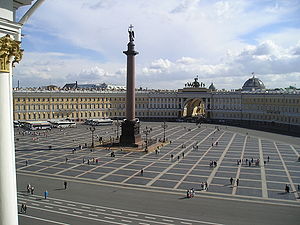
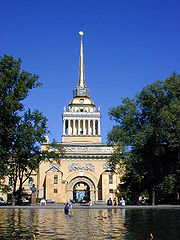
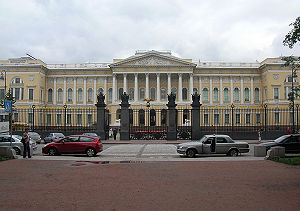





Peter and Paul Fortress
The Peter and Paul Fortress is the original citadel of St. Petersburg, Russia, founded by Peter the Great in 1703 and built to Domenico Trezzini's designs from 1706-1740.-History:...
with the Peter and Paul Cathedral
Peter and Paul Cathedral
The Peter and Paul Cathedral is a Russian Orthodox cathedral located inside the Peter and Paul Fortress in St. Petersburg, Russia. It is the first and oldest landmark in St. Petersburg, built between 1712 and 1733 on Zayachy Island along the Neva River. Both the cathedral and the fortress were...
takes dominant position on the right bank of the Neva river, across the Winter Palace
Winter Palace
The Winter Palace in Saint Petersburg, Russia, was, from 1732 to 1917, the official residence of the Russian monarchs. Situated between the Palace Embankment and the Palace Square, adjacent to the site of Peter the Great's original Winter Palace, the present and fourth Winter Palace was built and...
in the center of the city. A boardwalk
Boardwalk
A boardwalk, in the conventional sense, is a wooden walkway for pedestrians and sometimes vehicles, often found along beaches, but they are also common as paths through wetlands, coastal dunes, and other sensitive environments....
was built along a portion of the fortress wall, giving visitors a clear view of the city across the river to the south. On the other bank of the Neva, the spit (Strelka) of the Vasilievsky Island
Vasilievsky Island
Vasilyevsky Island is an island in Saint Petersburg, Russia, bordered by the rivers Bolshaya Neva and Malaya Neva in the south and northeast, and by the Gulf of Finland in the west. Vasilyevsky Island is separated from Dekabristov Island by the Smolenka River...
is graced by the Old Saint Petersburg Stock Exchange (Bourse) (1805–1810), an important lanmark in the style of the Greek Revival, is now home of the Russian Naval Museum. The spit of the Vasilievsky Island is designed as a classic lawn-park on the waterfront, and is highlighted by two tall and colorful Rostral Columns, decorated with statues and prows of battleships. This is a traditional place for music festivals and public events, such as the White Nights Festival
White Nights Festival
The White Nights Festival in St. Petersburg, Russia is an annual international arts festival during the season of the midnight sun. The White Nights Festival consists of a series of classical ballet, opera and music events and includes performances by Russian dancers, singers, musicians and actors,...
.
The most famous of St. Petersburg's museums is the Hermitage
Hermitage Museum
The State Hermitage is a museum of art and culture in Saint Petersburg, Russia. One of the largest and oldest museums of the world, it was founded in 1764 by Catherine the Great and has been opened to the public since 1852. Its collections, of which only a small part is on permanent display,...
, one of the world's largest and richest collections of Western European art. Its holdings were originally exhibited in the Greek Revival building (1838–1852) by Leo von Klenze
Leo von Klenze
Leo von Klenze was a German neoclassicist architect, painter and writer...
, now called the New Hermitage. But the first Russian museum was established by Peter the Great in the Kunstkammer
Kunstkamera
The Kunstkamera was the first museum in Russia. Established by Peter the Great and completed in 1727, the Kunstkammer Building hosts the Peter the Great Museum of Anthropology and Ethnography, with a collection of almost 2,000,000 items...
, erected in 1718–1734 on the opposite bank of the Neva River and formerly a home to the Russian Academy of Sciences
Russian Academy of Sciences
The Russian Academy of Sciences consists of the national academy of Russia and a network of scientific research institutes from across the Russian Federation as well as auxiliary scientific and social units like libraries, publishers and hospitals....
. Other important exhibitions are hosted by the State Russian Museum, the Russian Museum of Ethnography
Russian Museum of Ethnography
The Russian Museum of Ethnography is a museum in St. Petersburg that houses a collection of about 500,000 items relating to the ethnography, or cultural anthropology, of peoples of the former Russian Empire and the Soviet Union.The museum was set up in 1902 as the ethnographic department of the...
(1900–1911), Stieglitz Museum of Applied Arts
Stieglitz Museum of Applied Arts
The Stieglitz Museum of Decorative and Applied Arts ranks among the most significant museums in Saint Petersburg, Russia.The project had its beginnings in 1878 when Baron Alexander von Stieglitz , a millionaire philanthropist, donated funds to build a museum for the benefit of students of the...
(1885–1895), the Suvorov Museum of Military History (1901–1904), and the Political History Museum (1904–06).
The imperial government institutions were housed in stately buildings, such as the General Staff Building
General Staff Building (Saint Petersburg)
The General Staff Building is an edifice with a 580 m long bow-shaped facade, situated on Palace Square in Saint Petersburg, Russia, in front of the Winter Palace.The building was designed by Carlo Rossi in the Empire style and built in 1819-1829...
on the Palace Square
Palace Square
Palace Square , connecting Nevsky Prospekt with Palace Bridge leading to Vasilievsky Island, is the central city square of St Petersburg and of the former Russian Empire...
(1820–1827), with a huge triumphal arch in the centre, the Senate
Governing Senate
The Governing Senate was a legislative, judicial, and executive body of Russian Monarchs, instituted by Peter the Great to replace the Boyar Duma and lasted until the very end of the Russian Empire. It was chaired by the Ober-Procurator...
and Synod
Synod
A synod historically is a council of a church, usually convened to decide an issue of doctrine, administration or application. In modern usage, the word often refers to the governing body of a particular church, whether its members are meeting or not...
buildings on the Senate Square (1827–1843), the Imperial Cabinet (1803–1805) and the City Duma
Saint Petersburg City Duma
Saint Petersburg City Duma was established in 1785 in the course of Catherine the Great's municipal reform. Emperor Paul replaced it by the so-called Ratusha, but his son, Alexander I, had the Duma restored four years later. The next emperor, Nicholas I, expanded the institution from six to twelve...
(1784-87) on the Nevsky Prospekt, the Assignation Bank (1783–1790), the Customs Office (1829–1832), and the masterpiece of Russian architecture: the Admiralty (1806–1823), one of the city's most conspicuous landmarks. Most of Imperial palaces and state buildings were designed by reputable architects invited by the Russian Tsar's from European capitals, such as Domenico Trezzini
Domenico Trezzini
Domenico Trezzini was a Swiss Italian architect who elaborated the Petrine Baroque style of Russian architecture.Domenico was born in Astano, near Lugano, in the Italian-speaking Ticino . He probably studied in Rome...
, Giacomo Quarenghi
Giacomo Quarenghi
Giacomo Quarenghi was the foremost and most prolific practitioner of Palladian architecture in Imperial Russia, particularly in Saint Petersburg.- Career in Italy :...
, Thomas de Thomon, Bartolomeo Rastrelli
Bartolomeo Rastrelli
Francesco Bartolomeo Rastrelli was an Italian architect naturalized Russian. He developed an easily recognizable style of Late Baroque, both sumptuous and majestic...
, Carlo Rossi
Carlo Rossi (architect)
Carlo di Giovanni Rossi, was an Italian architect, who worked the major portion of his life in Russia. He was the author of many classical buildings and architectural ensembles in Saint Petersburg and its environments...
and other foreign architects who settled in St. Petersburg and worked on numerous large-scale projects. Next came the generation of Russian-born architects and engineers, such as Zakharov, Stasov, Voronikhin, Starov, and other Russians who studied abroad and returned to work in St. Petersburg.
The former imperial capital is rich in science and educational institutions. Saint Petersburg State University
Saint Petersburg State University
Saint Petersburg State University is a Russian federal state-owned higher education institution based in Saint Petersburg and one of the oldest and largest universities in Russia....
is based on Vasilievsky Island and in Peterhof. The university's baroque edifice of Twelve Collegia (1722–1744) was designed by Domenico Trezzini
Domenico Trezzini
Domenico Trezzini was a Swiss Italian architect who elaborated the Petrine Baroque style of Russian architecture.Domenico was born in Astano, near Lugano, in the Italian-speaking Ticino . He probably studied in Rome...
. The Academy of Arts (1764–1788) overlooks a quayside adorned with genuine Egypt
Egypt
Egypt , officially the Arab Republic of Egypt, Arabic: , is a country mainly in North Africa, with the Sinai Peninsula forming a land bridge in Southwest Asia. Egypt is thus a transcontinental country, and a major power in Africa, the Mediterranean Basin, the Middle East and the Muslim world...
ian sphinx
Sphinx
A sphinx is a mythical creature with a lion's body and a human head or a cat head.The sphinx, in Greek tradition, has the haunches of a lion, the wings of a great bird, and the face of a woman. She is mythicised as treacherous and merciless...
es. The Smolny Institute (1806–1808), originally the first school for Russian women, was Lenin's headquarters during the Russian Revolution of 1917
Russian Revolution of 1917
The Russian Revolution is the collective term for a series of revolutions in Russia in 1917, which destroyed the Tsarist autocracy and led to the creation of the Soviet Union. The Tsar was deposed and replaced by a provisional government in the first revolution of February 1917...
, is now the office of the Governor. The Catherine's Institute (1804–1807), also designed by Quarenghi, is now the Russian National Library
Russian National Library
The National Library of Russia in St Petersburg, known as the State Public Saltykov-Shchedrin Library from 1932 to 1992 , is the oldest public library in Russia...
. Another Neoclassical building by Quarenghi, a roomy Horse Guards Riding School (1804–1807), is now the Central Exhibition Hall.
Some historic shops and storehouses
Warehouse
A warehouse is a commercial building for storage of goods. Warehouses are used by manufacturers, importers, exporters, wholesalers, transport businesses, customs, etc. They are usually large plain buildings in industrial areas of cities and towns. They usually have loading docks to load and unload...
are landmarks in their own right, such as the monumental New Holland Arch (1779–1787) and adjacent walls of the New Holland isle
New Holland Island
New Holland Island in Saint Petersburg was created in 1720, when the newly built Kryukov Canal and Admiralty Canal connected the Moika River with the Neva...
. The Merchant Court
Gostiny Dvor
Great Gostiny Dvor is a vast department store on Nevsky Avenue in St Petersburg.This Gostiny Dvor is not only the city's oldest shopping centre, but also one of the first shopping arcades in the world...
on the Nevsky Prospekt
Nevsky Prospekt
Nevsky Avenue |Prospekt]]) is the main street in the city of St. Petersburg, Russia. Planned by Peter the Great as beginning of the road to Novgorod and Moscow, the avenue runs from the Admiralty to the Moscow Railway Station and, after making a turn at Vosstaniya Square, to the Alexander...
(1761–1785), also designed by Jean-Baptiste Vallin de la Mothe
Jean-Baptiste Vallin de la Mothe
thumb|St. Petersburg's [[Imperial Academy of Arts]]Jean-Baptiste Michel Vallin de la Mothe was a French architect whose major career was spent in St...
, houses the largest extant 18th-century shopping mall and supermarket in the world, now rebuilt and updated with several coffee bars and a metro station
Gostiny Dvor (Saint Petersburg Metro)
Gostiny Dvor is a station on the Nevsko-Vasileostrovskaya Line of the Saint Petersburg Metro. It was designed by architect C.G. Mayofis, E.S. Belyat, A.K. Andreyev, Ya.E. Moskalenko and C.P Schyukin and opened on November 3, 1967. It has two exits - one at the intersection between Griboyedov...
. Nearby are the Circular Market, erected in 1785–1790, and the Passage
The Passage
For the novel by Justin Cronin see The Passage The Passage , from the French word Passage, is an elite department store on Nevsky Avenue in Saint Petersburg, Russia, which celebrated its 150th anniversary in 1998...
, one of the great covered arcades
Arcade (architecture)
An arcade is a succession of arches, each counterthrusting the next, supported by columns or piers or a covered walk enclosed by a line of such arches on one or both sides. In warmer or wet climates, exterior arcades provide shelter for pedestrians....
of the mid-19th century.
Nevsky Prospekt
Nevsky Prospekt
Nevsky Avenue |Prospekt]]) is the main street in the city of St. Petersburg, Russia. Planned by Peter the Great as beginning of the road to Novgorod and Moscow, the avenue runs from the Admiralty to the Moscow Railway Station and, after making a turn at Vosstaniya Square, to the Alexander...
is the main avenue of St. Petersburg connecting the Winter Palace
Winter Palace
The Winter Palace in Saint Petersburg, Russia, was, from 1732 to 1917, the official residence of the Russian monarchs. Situated between the Palace Embankment and the Palace Square, adjacent to the site of Peter the Great's original Winter Palace, the present and fourth Winter Palace was built and...
with the monastery at Alexander Nevsky Lavra
Alexander Nevsky Lavra
Saint Alexander Nevsky Lavra or Saint Alexander Nevsky Monastery was founded by Peter I of Russia in 1710 at the eastern end of the Nevsky Prospekt in St. Petersburg supposing that that was the site of the Neva Battle in 1240 when Alexander Nevsky, a prince, defeated the Swedes; however, the battle...
. Nevsky is a busy shopping destination and center of entertainment and nighlife. Shopping malls, department store
Department store
A department store is a retail establishment which satisfies a wide range of the consumer's personal and residential durable goods product needs; and at the same time offering the consumer a choice of multiple merchandise lines, at variable price points, in all product categories...
s, business centers, built in a variety of styles, include the Elisseeff Emporium
Eliseyev Emporium (Saint Petersburg)
Elisseeff Emporium in St. Petersburg is a large retail and entertainment complex constructed in 1902-1903 for the Elisseeff Brothers. Located at 56 Nevsky Prospekt, the complex consists of three buildings, although the corner one is the structure that is referred to as Elisseeff’s store or shop...
, the House of Books, The Passage
The Passage
For the novel by Justin Cronin see The Passage The Passage , from the French word Passage, is an elite department store on Nevsky Avenue in Saint Petersburg, Russia, which celebrated its 150th anniversary in 1998...
, and more.
St Petersburg is a home to more than 50 theatre
Theatre
Theatre is a collaborative form of fine art that uses live performers to present the experience of a real or imagined event before a live audience in a specific place. The performers may communicate this experience to the audience through combinations of gesture, speech, song, music or dance...
s. The oldest is the Hermitage Theatre
Hermitage Theatre
The Hermitage Theatre in Saint Petersburg, Russia is one of five Hermitage buildings lining the Palace Embankment of the Neva River.The palatial theatre was built between 1783 and 1787 at the behest of Catherine the Great to a Palladian design by Giacomo Quarenghi...
, which was a private palatial theatre of Catherine the Great, still preserving the complex stage machinery of the 18th-century. The Alexandrine Theatre, built in 1828–1832 by Carlo Rossi, was named after the wife of Nicholas I
Nicholas I of Russia
Nicholas I , was the Emperor of Russia from 1825 until 1855, known as one of the most reactionary of the Russian monarchs. On the eve of his death, the Russian Empire reached its historical zenith spanning over 20 million square kilometers...
. Most famous outside Russia is the Mariinsky Theatre
Mariinsky Theatre
The Mariinsky Theatre is a historic theatre of opera and ballet in Saint Petersburg, Russia. Opened in 1860, it became the preeminent music theatre of late 19th century Russia, where many of the stage masterpieces of Tchaikovsky, Mussorgsky, and Rimsky-Korsakov received their premieres. The...
(former Kirov Theatre of Opera and Ballet), which has been styled the capital of the world ballet
Ballet
Ballet is a type of performance dance, that originated in the Italian Renaissance courts of the 15th century, and which was further developed in France and Russia as a concert dance form. The early portions preceded the invention of the proscenium stage and were presented in large chambers with...
. The Ciniselli Circus is one of the oldest circus buildings in the world. The Opera House at Saint Petersburg Conservatory
Saint Petersburg Conservatory
The N. A. Rimsky-Korsakov Saint Petersburg State Conservatory is a music school in Saint Petersburg. In 2004, the conservatory had around 275 faculty members and 1,400 students.-History:...
, the first in Russia, was founded in 1861 by Anton Rubinstein
Anton Rubinstein
Anton Grigorevich Rubinstein was a Russian-Jewish pianist, composer and conductor. As a pianist he was regarded as a rival of Franz Liszt, and he ranks amongst the great keyboard virtuosos...
and bears the name of Nikolai Rimsky-Korsakov
Nikolai Rimsky-Korsakov
Nikolai Andreyevich Rimsky-Korsakov was a Russian composer, and a member of the group of composers known as The Five.The Five, also known as The Mighty Handful or The Mighty Coterie, refers to a circle of composers who met in Saint Petersburg, Russia, in the years 1856–1870: Mily Balakirev , César...
; its alumni include Tchaikovsky
Pyotr Ilyich Tchaikovsky
Pyotr Ilyich Tchaikovsky Pyotr Ilyich Tchaikovsky Pyotr Ilyich Tchaikovsky (Russian: Пётр Ильи́ч Чайко́вский ; often "Peter Ilich Tchaikovsky" in English. His names are also transliterated "Piotr" or "Petr"; "Ilitsch", "Il'ich" or "Illyich"; and "Tschaikowski", "Tschaikowsky", "Chajkovskij"...
, Prokofiev
Sergei Prokofiev
Sergei Sergeyevich Prokofiev was a Russian composer, pianist and conductor who mastered numerous musical genres and is regarded as one of the major composers of the 20th century...
, and Shostakovich
Dmitri Shostakovich
Dmitri Dmitriyevich Shostakovich was a Soviet Russian composer and one of the most celebrated composers of the 20th century....
who also taught here.
Monuments and sculptures

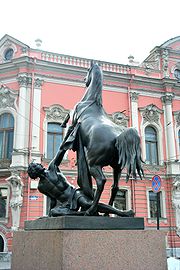
Equestrian sculpture
An equestrian statue is a statue of a rider mounted on a horse, from the Latin "eques", meaning "knight", deriving from "equus", meaning "horse". A statue of a riderless horse is strictly an "equine statue"...
of Peter the Great
Peter I of Russia
Peter the Great, Peter I or Pyotr Alexeyevich Romanov Dates indicated by the letters "O.S." are Old Style. All other dates in this article are New Style. ruled the Tsardom of Russia and later the Russian Empire from until his death, jointly ruling before 1696 with his half-brother, Ivan V...
, known as the Bronze Horseman and installed in 1782 on the Senate Square. Considered the greatest masterpiece of the French-born Etienne Maurice Falconet
Étienne Maurice Falconet
Étienne Maurice Falconet is counted among the first rank of French Rococo sculptors, whose patron was Mme de Pompadour.-Life:Falconet was born to a poor family in Paris...
, Aleksandr Pushkin
Aleksandr Pushkin
Alexander Sergeyevich Pushkin was a Russian author of the Romantic era who is considered by many to be the greatest Russian poet and the founder of modern Russian literature....
's poem about the statue figures prominently in the Russian literature under the name of The Bronze Horseman
The Bronze Horseman (poem)
The Bronze Horseman: A Petersburg Tale is a narrative poem written by Aleksandr Pushkin in 1833 about the equestrian statue of Peter the Great in Saint Petersburg. Widely considered to be Pushkin's most successful narrative poem, "The Bronze Horseman" has had a lasting impact on Russian...
.
The Palace Square
Palace Square
Palace Square , connecting Nevsky Prospekt with Palace Bridge leading to Vasilievsky Island, is the central city square of St Petersburg and of the former Russian Empire...
is dominated by the Alexander Column
Alexander Column
The Alexander Column also known as Alexandrian Column , is the focal point of Palace Square in Saint Petersburg, Russia. The monument was erected after the Russian victory in the war with Napoleon's France...
(1830–1834), the tallest of its kind in the world and so nicely set that no attachment to the base is needed. A monument to Generalissimo
Generalissimo
Generalissimo and Generalissimus are military ranks of the highest degree, superior to Field Marshal and other five-star ranks.-Usage:...
Suvorov, represented as a youthful god of war, was erected in 1801 on the Field of Mars
Field of Mars (Saint Petersburg)
The Field of Mars or Marsovo Polye is a large park named after the Mars - Roman god of war situated in the center of Saint-Petersburg, with an area of about 9 hectares. Bordering the Field of Mars to the north are the Marble Palace, Suvorova Square and Betskoi’s and Saltykov’s houses. To the west...
, formerly used for military parades and popular festivities. Saint Isaac's Square is graced by the Monument to Nicholas I
Monument to Nicholas I
The Monument to Nicholas I is a bronze equestrian monument of Nicholas I of Russia on St Isaac's Square in Saint Petersburg, Russia...
(1856–1859), which was spared by Bolshevik
Bolshevik
The Bolsheviks, originally also Bolshevists , derived from bol'shinstvo, "majority") were a faction of the Marxist Russian Social Democratic Labour Party which split apart from the Menshevik faction at the Second Party Congress in 1903....
authorities from destruction as the first equestrian
Equestrian sculpture
An equestrian statue is a statue of a rider mounted on a horse, from the Latin "eques", meaning "knight", deriving from "equus", meaning "horse". A statue of a riderless horse is strictly an "equine statue"...
statue in the world with merely two support points (the rear feet of the horse).
The public monument
Monument
A monument is a type of structure either explicitly created to commemorate a person or important event or which has become important to a social group as a part of their remembrance of historic times or cultural heritage, or simply as an example of historic architecture...
s of St Petersburg also include Mikeshin's circular statue of Catherine II on the Nevsky Avenue
Nevsky Prospekt
Nevsky Avenue |Prospekt]]) is the main street in the city of St. Petersburg, Russia. Planned by Peter the Great as beginning of the road to Novgorod and Moscow, the avenue runs from the Admiralty to the Moscow Railway Station and, after making a turn at Vosstaniya Square, to the Alexander...
, fine horse statues on the Anichkov Bridge
Anichkov Bridge
The Anichkov Bridge is the first and most famous bridge across the Fontanka River in Saint Petersburg, Russia. The current bridge, built in 1841-42 and reconstructed in 1906-08, combines a simple form with some spectacular decorations...
, a Rodin
Auguste Rodin
François-Auguste-René Rodin , known as Auguste Rodin , was a French sculptor. Although Rodin is generally considered the progenitor of modern sculpture, he did not set out to rebel against the past...
-like equestrian statue of Alexander III
Alexander III of Russia
Alexander Alexandrovich Romanov , historically remembered as Alexander III or Alexander the Peacemaker reigned as Emperor of Russia from until his death on .-Disposition:...
by Paolo Troubetzkoy
Paolo Troubetzkoy
Prince Paolo or Paul Troubetzkoy was an artist and a sculptor, of Russia's Troubetzkoy princely family, who was described by G.B. Shaw as "the most astonishing sculptor of modern times".-Life:He worked in Russia, America, England and Italy...
, and the Tercentenary monument presented by France
France
The French Republic , The French Republic , The French Republic , (commonly known as France , is a unitary semi-presidential republic in Western Europe with several overseas territories and islands located on other continents and in the Indian, Pacific, and Atlantic oceans. Metropolitan France...
in 2003 and installed on the Sennaya Square
Sennaya Square
Sennaya Square or Sennaya Ploshchad , known as Peace Square between 1963 and 1991, is a large city square in Central Saint Petersburg, located at the crossing of Garden Street, Moskovsky Prospekt, and Grivtsova Lane....
.
Some of the most important events in the history of both the city and the Russian Empire are represented by particular monuments. The Russian victory over Napoleon, for example, was commemorated by the Narva Triumphal Gate
Narva Triumphal Gate
The Narva Triumphal Arch was erected in the vast Narva Square , Saint Petersburg, in 1814 to commemorate the Russian victory over Napoleon. The wooden structure was constructed on the Narva highway with the purpose of greeting the soldiers who were returning from abroad after their victory over...
(1827–1834), and the victory in the Russo-Turkish War, 1828-1829
Russo-Turkish War, 1828-1829
The Russo–Turkish War of 1828–1829 was sparked by the Greek War of Independence. The war broke out after the Sultan, incensed by the Russian participation in the Battle of Navarino, closed the Dardanelles for Russian ships and revoked the Akkerman Convention....
— by the Moscow Triumphal Gates
Moscow Triumphal Gates
The Moscow Triumphal Gate is a Neoclassical triumphal arch in Saint Petersburg, Russia. The monument — built mainly in cast iron — was erected in 1834 -1838 in the memory of the Russian victory in the Russo-Turkish War, 1828-1829.-19th century:...
(1834–1838). The Piskarevskoye Cemetery was opened in 1960 as a monument to the victims of the 900-Day Siege
Siege of Leningrad
The Siege of Leningrad, also known as the Leningrad Blockade was a prolonged military operation resulting from the failure of the German Army Group North to capture Leningrad, now known as Saint Petersburg, in the Eastern Front theatre of World War II. It started on 8 September 1941, when the last...
.
Suburban parks and palaces
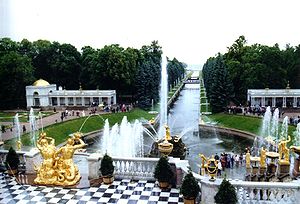

Catherine Palace
The Catherine Palace was the Rococo summer residence of the Russian tsars, located in the town of Tsarskoye Selo , 25 km south-east of St. Petersburg, Russia.- History :...
and the neoclassical Alexander Palace
Alexander Palace
The Alexander Palace is a former imperial residence at Tsarskoye Selo, on a plateau around 30 minutes by train from St Petersburg. It is known as the favourite residence of the last Russian Emperor, Nicholas II, and his family and their initial place of imprisonment after the revolution that...
; and Pavlovsk Palace
Pavlovsk Palace
Pavlovsk Palace is an 18th-century Russian Imperial residence built by Paul I of Russia near Saint Petersburg. After his death, it became the home of his widow, Maria Feodorovna...
, which contains a domed palace of Emperor Paul
Paul I of Russia
Paul I was the Emperor of Russia between 1796 and 1801. He also was the 72nd Prince and Grand Master of the Order of Malta .-Childhood:...
(1782–1786) and a large English-style park.
Much of Peterhof and Tsarskoe Selo had to be restored after being blown up by the retreating Germans in 1944. Other imperial residences have yet to be revived to their former glory. Gatchina
Gatchina
Gatchina is a town and the administrative center of Gatchinsky District of Leningrad Oblast, Russia, located south of St. Petersburg by the road leading to Pskov...
, lying 45 km southwest of St Petersburg, retains a royal castle
Castle
A castle is a type of fortified structure built in Europe and the Middle East during the Middle Ages by European nobility. Scholars debate the scope of the word castle, but usually consider it to be the private fortified residence of a lord or noble...
with 600 rooms surrounded by a park. Oranienbaum
Oranienbaum, Russia
Oranienbaum is a Russian royal residence, located on the Gulf of Finland west of St. Petersburg. The Palace ensemble and the city centre are UNESCO World Heritage Sites.-History:...
, founded by Prince Menshikov, features his spacious baroque residence and the richly decorated Chinese palace. Strelna
Strelna
Strelna is a municipal settlement in Petrodvortsovy District of the federal city of St. Petersburg, Russia, situated about halfway between St. Petersburg proper and Petergof and overlooking the shore of the Gulf of Finland...
has a hunting lodge of Peter the Great
Peter I of Russia
Peter the Great, Peter I or Pyotr Alexeyevich Romanov Dates indicated by the letters "O.S." are Old Style. All other dates in this article are New Style. ruled the Tsardom of Russia and later the Russian Empire from until his death, jointly ruling before 1696 with his half-brother, Ivan V...
and the reconstructed Constantine Palace, used for official summits of the Russian president with foreign leaders.
Another notable suburb is Kronstadt
Kronstadt
Kronstadt , also spelled Kronshtadt, Cronstadt |crown]]" and Stadt for "city"); is a municipal town in Kronshtadtsky District of the federal city of St. Petersburg, Russia, located on Kotlin Island, west of Saint Petersburg proper near the head of the Gulf of Finland. Population: It is also...
, with its 19th-century fortifications and naval monuments. Catherinehof
Catherinehof
Ekaterinhof or Catherinehof is a historic district in the south-west of St Petersburg, Russia. Its name originated in 1711, when Peter the Great presented the Ekanerinhof Island and adjacent lands along the Ekateringofka River to his wife Catherine, whose name they memorialize.The emperor...
, originally intended as a garden suburb, was engulfed by the city in the 19th century.

